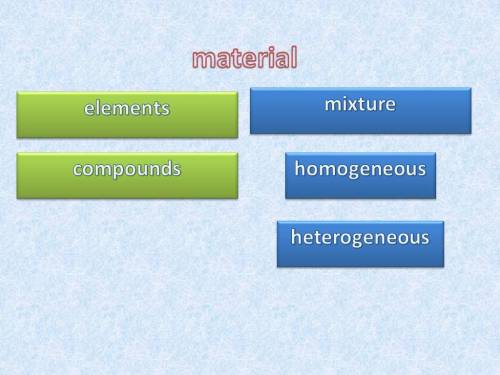
Chemistry, 11.07.2019 10:00, vivian2020
Check my answers, ? 1. which of the following is not an example of matter? a. air b. heat* c. smoke d. water vapor 2. all of the following are physical properties of matter except a. mass* b. color c. melting point d. ability to rust 3. a vapor is which state of matter? a. solid b. liquid c. gas d. all of the above* 4. which state of matter is characterized by having an indefinite shape, but a different volume? a. gas b. liquid* c. solid d. none of the above 5. which of the following is a physical change? a. corrosion b. explosion c. evaporation d. rotting of food* you in advance

Answers: 2
Other questions on the subject: Chemistry

Chemistry, 21.06.2019 13:00, willcohen42
What postulate of the kinetic molecular theory best explains why gases have high fluidity? because collisions between gas particles are elastic, there is no loss of energy as particles flow past each other. because gases consist of large numbers of tiny particles, they spread out and do not come in contact with each other. because the attractive forces between gas particles are negligible, gas particles can glide easily past one another. because the average kinetic energy of gas particles increases as temperature increases, gas particles behave more like a liquid. question 6 compare the compressibility of gases and liquids. support your answer by describing the arrangement of particles in gases and liquids.
Answers: 1


Chemistry, 22.06.2019 19:00, andrecoral105
A4.86 g piece of metal was placed in a graduated cylinder containing 15.5 ml of water. the water level rose to 17.3 ml. what is the density of the metal. i need the steps of how to solve it to so i can use a formula to work out other problems.
Answers: 1

Chemistry, 22.06.2019 20:10, jakhunter354
The lattice enthalpy (formation of ionic solid from ions in the gas phase) for agcl(s) is -916 kj/mol and the hydration enthalpy (dissolution of gaseous ions into water) is -850 kj/mol. how much heat (in joules) is involved in forming 1l of saturated agcl solution (1.8 × 10-4 g / 100 ml water) by dissolving agcl(s)? assume solution volume does not change much upon dissolution. the equations are given below. ag+(g) + cl−(g) æ agcl(s)
Answers: 3
Do you know the correct answer?
Check my answers, ? 1. which of the following is not an example of matter? a. air b. heat* c. smo...
Questions in other subjects:

Mathematics, 13.04.2021 22:50




English, 13.04.2021 22:50


Physics, 13.04.2021 22:50









